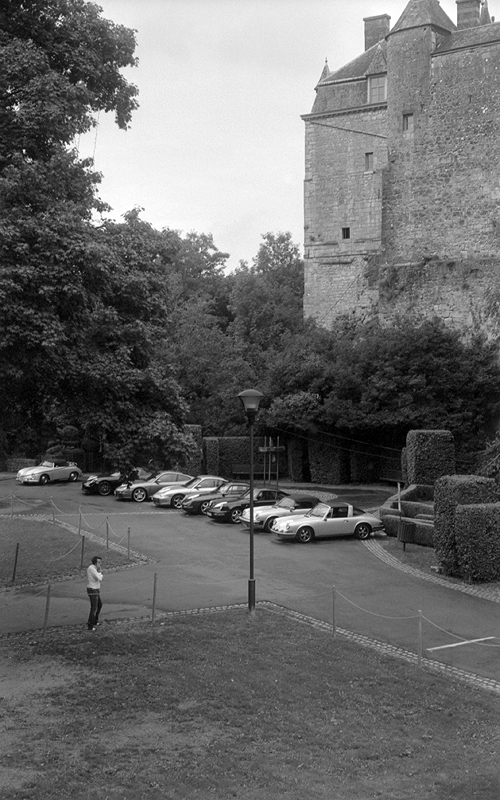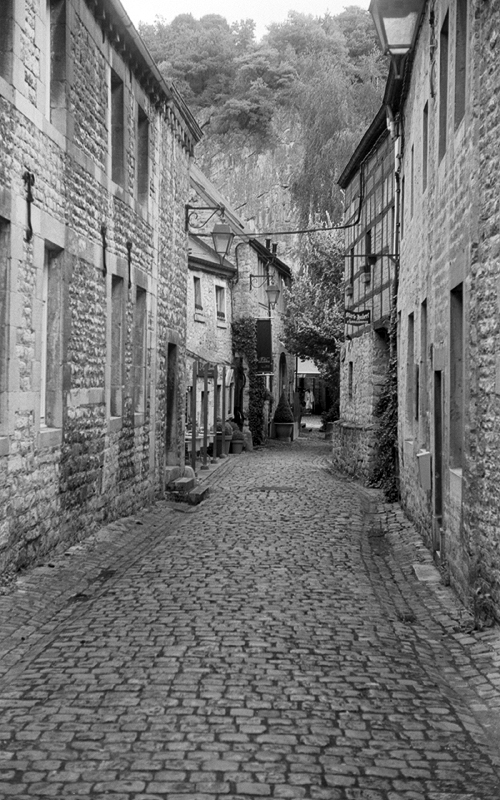You are using an out of date browser. It may not display this or other websites correctly.
You should upgrade or use an alternative browser.
You should upgrade or use an alternative browser.
Testing a Xenon....
- Thread starter Vince Lupo
- Start date
- Latest activity Latest activity:
- Replies 71
- Views 11K
Mr_Flibble
In Tabulas Argenteas Refero
The front and rear surface of my 1937 Two-ring Xenon I've polished ever so slightly. That got rid of a LOT of cleaning marks. It was a difficult lens to figure out how to take it apart and fix it; When I got it the lens tube was spinning freely in the focus mount, that probably made it go for cheap. And the rear lens group wasn't screwed on properly.
I currently have it mounted on my Leica IIIb.
For a hood I use a 41mm to 43mm step-up-ring and a vented circular hood. It's okay though it does tend to block parts of the viewfinder.
For filters I found the Summarit bayonet filter will fit...but barely.

I currently have it mounted on my Leica IIIb.
For a hood I use a 41mm to 43mm step-up-ring and a vented circular hood. It's okay though it does tend to block parts of the viewfinder.
For filters I found the Summarit bayonet filter will fit...but barely.

Vince Lupo
Whatever
How are you polishing the lens? What are you using?
sanmich
Veteran
You could try Marc Nicolas in France for repolishing:
http://www.nicorep.fr/
http://www.nicorep.fr/
Vince Lupo
Whatever
You guys might think I'm nuts, but I tried something that I've heard about and read about (may be an urban legend???), and it believe it or not, it seems to have helped......
I took a little bit of Blue Magic Metal Polish Cream (for chrome and aluminum), put it on a microfiber lens cloth, and gently applied it to the front element. Look at the result:

Maybe a bit hard to tell in this light, but I'm pretty convinced that it got rid of all that spotty, smeariness that was on the front element. If you look at the very first colour photo in this thread, you can see it all on the front element.
I did a shot this morning - mind you, in flat early-morning light:

Still flat, to be sure. Any better? I think I'd have to do another shot in the same conditions as yesterday to be certain. It does appear, though, that I took a bit of that highlight glow away and it's a bit crisper.
A 'tweaked' version of the photo:

Considering I don't have much money in this lens (and I don't wish to put much more into this lens!), it was worth taking the risk. And I'm pretty convinced the front element looks better!
I took a little bit of Blue Magic Metal Polish Cream (for chrome and aluminum), put it on a microfiber lens cloth, and gently applied it to the front element. Look at the result:

Maybe a bit hard to tell in this light, but I'm pretty convinced that it got rid of all that spotty, smeariness that was on the front element. If you look at the very first colour photo in this thread, you can see it all on the front element.
I did a shot this morning - mind you, in flat early-morning light:

Still flat, to be sure. Any better? I think I'd have to do another shot in the same conditions as yesterday to be certain. It does appear, though, that I took a bit of that highlight glow away and it's a bit crisper.
A 'tweaked' version of the photo:

Considering I don't have much money in this lens (and I don't wish to put much more into this lens!), it was worth taking the risk. And I'm pretty convinced the front element looks better!
Erik van Straten
Veteran
Still flat, to be sure.
Try the lens on a film camera and scan the film (adapt the histogram). Rick's results with the lens on a IIIb are better!
Erik.
02Pilot
Malcontent
FWIW, I've used Flitz metal polish on several lenses with one sort of nastiness or another affected them and seen marked improvement in every case. I'm not surprised yours got better after similar treatment.
raytoei@gmail.com
Veteran
errr.isn't blue magic metal cream meant for metal and headlight covers ? i wonder does it clean off a layer of coating and thus removing the cleaning marks or does it fill in the scratches and thus covering it ?
curious.
curious.
Vince Lupo
Whatever
Yes, errr that's what it is. It's a chrome and aluminum polish. It doesn't fill in the scratches, it seems to remove the cleaning marks and the fogginess.
And please note I didn't exactly glob it on - I used a very tiny bit on a microfiber lens cloth and rubbed very gently. It is non-abrasive.
Here is the stuff that I used:


And please note I didn't exactly glob it on - I used a very tiny bit on a microfiber lens cloth and rubbed very gently. It is non-abrasive.
Here is the stuff that I used:


Vince Lupo
Whatever
A few more test shots today -- these done in more contrasty daylight:



Obviously the image contrast is helped by the more contrasty lighting situation that we had today. These are all JPEGS straight from the camera, and shot at about f/3.2. I've been trying to shoot as wide open as possible to see what the lens can really do. What I've discovered with these photos is that the lens is much sharper in the center than it is on the edges. As well, if I focus on something and then reframe it so that it's off to one side of the frame, it does not stay in focus. Now this might possibly be due to the f/3.2 aperture setting, or it's just the way the design of this lens is.
I'll try to do some shots at smaller aperture settings (like f/6.3) to see what it does. I may also do a Xenon-Summar comparison, just for fun. Stay tuned!



Obviously the image contrast is helped by the more contrasty lighting situation that we had today. These are all JPEGS straight from the camera, and shot at about f/3.2. I've been trying to shoot as wide open as possible to see what the lens can really do. What I've discovered with these photos is that the lens is much sharper in the center than it is on the edges. As well, if I focus on something and then reframe it so that it's off to one side of the frame, it does not stay in focus. Now this might possibly be due to the f/3.2 aperture setting, or it's just the way the design of this lens is.
I'll try to do some shots at smaller aperture settings (like f/6.3) to see what it does. I may also do a Xenon-Summar comparison, just for fun. Stay tuned!
Vince Lupo
Whatever
Luddite Frank
Well-known
errr.isn't blue magic metal cream meant for metal and headlight covers ? i wonder does it clean off a layer of coating and thus removing the cleaning marks or does it fill in the scratches and thus covering it ?
curious.
It probably would remove lens-coating, but I believe the Xenon is an un-coated lens. 😕
It looks significantly better, Vince !
Vince Lupo
Whatever
I think so too!
And yes, it is an uncoated lens.
And yes, it is an uncoated lens.
sebastel
coarse art umbrascriptor
i like it.
(10 chars)
(10 chars)
Mr_Flibble
In Tabulas Argenteas Refero
I used an even more DIY method, Vince. I used toothpaste 😉
Looks like yours cleaned up very well too.
Erik, the photo I placed was taken with Rollei Superpan 200. I did apply a slight s-curve for improved contrast on that one.

And wide-open

Looks like yours cleaned up very well too.
Erik, the photo I placed was taken with Rollei Superpan 200. I did apply a slight s-curve for improved contrast on that one.

And wide-open

Vince Lupo
Whatever
Your results look good too. Now let me ask you -- should this 'cleaning' method only be attempted on non-coated lenses? I've only tried it on this one lens, and only because I had nothing to lose.
As well,are you finding your lens to be sharper in the middle than on the edges?
As well,are you finding your lens to be sharper in the middle than on the edges?
02Pilot
Malcontent
I've used Flitz metal polish on coated and uncoated lenses, albeit the coated ones were more modern and not known for soft coatings. It didn't seem to disturb reasonably hard coatings, but I have no knowledge of how it might affect old, soft ones. I only use it when other, more gentle methods have failed and there's little to lose.
Vince Lupo
Whatever
Yes I think one could consider this method a 'what have I got to lose' approach.
With this particular Xenon, it was part of a 'lot' of cameras that I bought, and the owner basically threw it in along with a really needy Leica IIIb body (which I have and will likely sell). I sent it to Frank Marshman and he made the focus and aperture work like new, and he cleaned it as best he could.
Combined with Frank's stellar work, this polishing method transformed a 'freebie' into quite a worthwhile lens.
With this particular Xenon, it was part of a 'lot' of cameras that I bought, and the owner basically threw it in along with a really needy Leica IIIb body (which I have and will likely sell). I sent it to Frank Marshman and he made the focus and aperture work like new, and he cleaned it as best he could.
Combined with Frank's stellar work, this polishing method transformed a 'freebie' into quite a worthwhile lens.
Mr_Flibble
In Tabulas Argenteas Refero
Vince,
Like you, I had nothing to lose when I decided to polish it. I did a little research on how to go about it and what I needed.
I have only tried it on a pre-war uncoated tessar but this did nothing to improve it.
Some of the Xenons were coated during the war years, and Leitz certainly offered it as an upgrade to uncoated lenses after the war.
I find the central sharpeness to be okay between f/2.8 and f/4
Overall sharpness and contrast improves when you stop down beyond f/4 though.
Like you, I had nothing to lose when I decided to polish it. I did a little research on how to go about it and what I needed.
I have only tried it on a pre-war uncoated tessar but this did nothing to improve it.
Some of the Xenons were coated during the war years, and Leitz certainly offered it as an upgrade to uncoated lenses after the war.
I find the central sharpeness to be okay between f/2.8 and f/4
Overall sharpness and contrast improves when you stop down beyond f/4 though.
Erik van Straten
Veteran
the photo was taken with Rollei Superpan 200. I did apply a slight s-curve for improved contrast on that one.
I must say that I do not have any experience with digital photography, but from what I see I think that old lenses like this one work better with film. It is as if digital cameras amplify the shortcomings of the lenses. On film the shortcomings have a kind of charming effect instead. Maybe this is all nonsense however, very subjective for sure.
Erik.
Similar threads
- Replies
- 4
- Views
- 522
- Replies
- 21
- Views
- 2K
- Replies
- 28
- Views
- 690
- Replies
- 11
- Views
- 713





